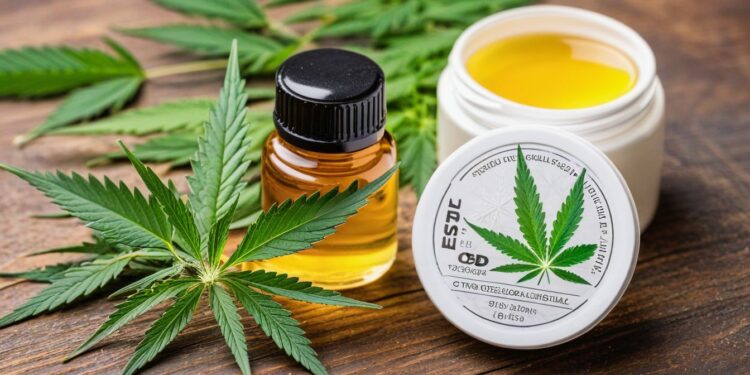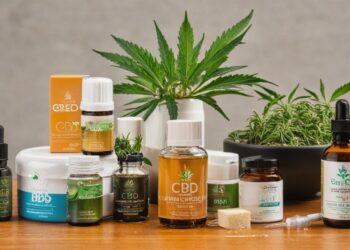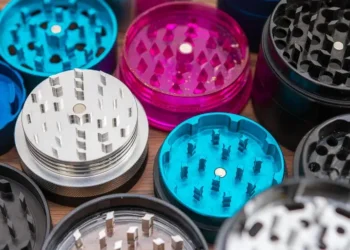Unveiling the Verdant Voyage: Navigating CBD’s Path from Seed to Serenity
Introduction to CBD and Holistic Wellness
The Journey Begins: Unveiling the Power of CBD
Picture this: a natural compound derived from cannabis plants that holds immense potential for holistic wellness. Enter CBD, also known as cannabidiol, a non-psychoactive component that has taken the health and wellness industry by storm.
But what exactly is this miraculous substance? CBD is one of over 100 chemical compounds, known as cannabinoids, found in the cannabis plant.
Unlike its notorious counterpart THC (tetrahydrocannabinol), CBD does not induce a mind-altering high. Instead, it offers an array of therapeutic benefits without any intoxicating effects – truly nature’s gift to those seeking relief.
A Holistic Paradigm Shift: Embracing Mind-Body-Spirit Connection
In our fast-paced modern society, where stress and anxiety seem omnipresent, seeking a holistic approach to wellness has become imperative. Holistic wellness recognizes that optimal health encompasses not only physical well-being but also mental and spiritual harmony.
It advocates for treating the whole person rather than merely addressing symptoms. At its core, holistic wellness believes in the interconnectedness of our mind, body, and spirit.
It acknowledges that imbalances in one area can manifest as ailments or distress in other areas. By adopting this approach, individuals can achieve overall well-being and improve their quality of life.
The Synergy between CBD and Holistic Wellness
Now imagine combining the therapeutic potential of CBD with the principles of holistic wellness – a match made in heaven! The advent of CBD has invigorated the pursuit of alternative methods to support overall health.
CBD interacts with our body’s endocannabinoid system (ECS), responsible for maintaining balance or homeostasis within various bodily functions such as mood regulation, immune response, and pain perception. By engaging with our ECS, CBD can potentially enhance its natural functions and promote overall well-being.
CBD’s non-psychoactive nature makes it an appealing option for those seeking a natural alternative to conventional medication. Whether used topically or ingested, CBD has shown promise in alleviating chronic pain, reducing anxiety and depression symptoms, improving sleep quality, and even aiding in the management of epilepsy.
As we embark on this journey from seed to relief, we will explore the fascinating origins of CBD and how it ties into the principles of holistic wellness. Join us as we uncover the secrets behind cultivating cannabis plants specifically for CBD production and shed light on the transformative effects of incorporating CBD into a holistic lifestyle.
The Origins of CBD
Tracing the historical use of cannabis for medicinal purposes in ancient civilizations
Magnificent Mary Jane: A Medicinal Marvel from the Ancient Times Oh, how our ancestors treasured the bountiful plant we now call cannabis!
Throughout the annals of history, this extraordinary herb has been hailed as a powerful remedy by countless civilizations. From the Egyptians to the Chinese and even our wise friends in ancient Greece, cannabis was revered for its therapeutic properties.
The early writings of these esteemed cultures provide a window into their understanding and utilization of this botanical wonder. Let’s embark on a journey through time!
In ancient Egypt, papyrus scrolls reveal that they used cannabis for various ailments like inflammation and pain relief. Meanwhile, in China, emperors and healers brewed concoctions with cannabis to treat conditions ranging from rheumatism to malaria.
Fast forward to ancient Greece, where Hippocrates himself wrote about cannabis as an effective painkiller. The Greeks also valued its usefulness in easing menstrual discomfort – a testament that women have cherished plants’ healing powers since time immemorial.
Discovery and isolation of CBD as a distinct compound in the 1940s
Unveiling CBD’s Hidden Treasure: A Scientific Breakthrough It wasn’t until the mid-20th century that we began unraveling one of nature’s best-kept secrets – cannabidiol or CBD.
Enter Dr. Roger Adams, an American chemist who conducted groundbreaking research in 1940 that led him down an enlightening path towards isolating this remarkable compound. Dr. Adams successfully extracted CBD from hemp plants, revealing its potential therapeutic benefits without inducing mind-altering effects typically associated with another famous compound found in cannabis – tetrahydrocannabinol (THC).
This watershed moment marked the separation between CBD and THC as distinct entities within these versatile plants. As scientific understanding grew, subsequent studies shed light on CBD’s interactions with the human body.
Researchers gradually uncovered its fascinating ability to modulate receptors in our endocannabinoid system, a complex network responsible for maintaining balance and harmony within us. It became evident that CBD held immense promise as a natural remedy for an array of ailments, igniting a wave of interest and exploration into its therapeutic potential.
From ancient civilizations to modern-day laboratories, the narrative of CBD has unfolded like an enthralling tale of discovery. While our ancestors may not have understood the compound as we do today, they recognized cannabis’ profound healing qualities.
And thanks to pioneers like Dr. Adams, we can now delve deeper into the intricate mechanisms behind this botanical treasure: CBD. (Note: This article is intended for informational purposes only and does not constitute medical advice.)
Cultivating Cannabis for CBD Production
Understanding different strains and their varying CBD levels
When it comes to cultivating cannabis for CBD production, understanding the different strains available and their varying CBD levels is crucial. There are numerous cannabis strains out there, each with its own unique characteristics, including the amount of CBD it contains. Some strains have higher levels of CBD, while others may contain more THC (the psychoactive compound).
It’s important to choose a strain that aligns with your desired CBD content. For example, you might consider growing a strain like Charlotte’s Web if you’re looking for a high-CBD strain.
Named after a young girl who found relief from her seizures through this specific strain, Charlotte’s Web is known for its low THC content and high amounts of CBD. On the other hand, if you’re not concerned about THC levels and are seeking a balanced cannabinoid profile, a strain like ACDC or Harlequin might be more suitable.
Exploring organic farming methods to ensure high-quality CBD production
To ensure high-quality CBD production, many cultivators are turning towards organic farming methods. Organic cultivation involves working in harmony with nature while avoiding synthetic chemicals and pesticides that could potentially contaminate the final product.
One popular technique used in organic farming is companion planting. This involves strategically planting beneficial plants alongside cannabis plants to ward off pests naturally and attract pollinators.
For instance, planting marigolds near cannabis plants can repel aphids and nematodes. Additionally, organic farmers focus on building healthy soil through practices such as composting and using cover crops that enrich the soil’s nutrients organically.
By nurturing the soil ecosystem, these farmers create an optimal environment for cannabis plants to thrive without relying on harmful chemicals. Another key aspect of organic cultivation is water conservation.
Implementing drip irrigation systems helps minimize water waste by delivering water directly to the roots of the plants, reducing evaporation and runoff. This approach not only preserves a vital resource but also supports sustainable farming practices.
Cultivating cannabis for CBD production requires a deep understanding of different strains and their varying CBD levels. By selecting strains that align with the desired CBD content, cultivators can ensure they are growing plants that will contribute to their specific goals.
Exploring organic farming methods is crucial for producing high-quality CBD. By adopting techniques such as companion planting, enriching soil health through composting, and implementing water conservation practices, cultivators can cultivate cannabis in an environmentally friendly manner.
As the demand for CBD continues to rise in the holistic wellness industry, it is essential for cultivators to stay informed about the latest research and advancements in cultivation techniques. By combining knowledge with sustainable practices, growers can play a vital role in providing consumers with high-quality CBD products that support overall well-being.
Germination: The First Stage where Seeds Sprout into Seedlings
Germination is the magical moment when a tiny seed awakens and begins its journey towards becoming a robust CBD-rich cannabis plant. To ensure successful germination, it’s essential to create optimal conditions for these little wonders to thrive. Temperature and moisture levels play a pivotal role in this process.
Seeds require a warm and humid environment to sprout. The ideal temperature range for germination is typically between 70-85°F (21-29°C).
Lower temperatures can slow down or inhibit germination, while higher temperatures may lead to poor seedling development. In addition to temperature, maintaining the right moisture level is vital.
Seeds need enough moisture to soften their outer shell and activate enzymes that trigger growth. However, excessive water can cause seeds to rot.
A common method is using paper towels or moistened soil in a container with good drainage. It’s important not to let them dry out entirely or become waterlogged.
Importance of Selecting Viable Seeds with High CBD Content
When embarking on the journey of growing CBD-rich cannabis plants, starting with high-quality seeds is paramount. Investing in viable seeds ensures that you have the genetic potential for plants with high CBD content.
Look for reputable seed banks or breeders known for their focus on CBD-rich strains, as they prioritize producing stable genetics with consistent cannabinoid profiles. Reliable sources often provide detailed information about THC-to-CBD ratios and potential terpene profiles, allowing you to choose seeds best suited for your desired therapeutic effects.
Remember, it’s crucial not only to consider high CBD levels but also strive for genetic stability and reliable germination rates when selecting seeds. Investing in quality seeds sets the foundation for success throughout your cultivation journey.
Vegetative Stage: Nurturing Healthy Plants before Flowering
The vegetative stage is an important period where your cannabis plants focus on building a strong foundation before entering the flowering stage. During this phase, providing the ideal light cycles, nutrition, and employing proper pruning techniques contribute to healthy plant growth. Cannabis plants thrive under approximately 18 hours of light per day during the vegetative stage.
This prolonged exposure to light promotes vigorous growth in both height and foliage development. Some growers prefer using specialized grow lights that emit specific wavelengths to optimize plant growth and CBD production.
Nutrition is another critical aspect of nurturing healthy cannabis plants. Providing a balanced nutrient solution that includes essential macronutrients (nitrogen, phosphorus, potassium) as well as micronutrients (calcium, magnesium, iron) ensures optimal growth and vitality.
Remember to monitor pH levels regularly to prevent nutrient deficiencies or toxicities. Implementing proper pruning techniques helps shape the plant’s structure by encouraging lateral branching and airflow between leaves.
Removing lower leaves that receive minimal light can redirect energy towards upper foliage where most photosynthesis occurs. This practice aids in preventing mold or mildew issues caused by excess moisture trapped within dense foliage.

Harvesting and Processing the Crop
Determining the right time to harvest based on desired cannabinoid profile
When it comes to harvesting CBD-rich cannabis plants, timing is everything. Just like a fine wine needs to be aged to achieve optimal flavor, CBD plants need to be harvested at the right moment to ensure desired cannabinoid levels. The ideal time for harvest varies depending on the strain, but generally falls somewhere between 8-12 weeks after flowering begins.
But how do growers determine this magical moment? Well, it’s all about observing those sticky buds!
Trichomes are tiny, crystal-like structures on the surface of cannabis flowers that house essential oils and cannabinoids. To gauge when to harvest, growers closely inspect these trichomes under a magnifying glass.
When they transition from transparent to an opaque milky-white color, it’s a clear sign that the plant has reached its peak CBD potency. However, if left too long, trichomes can turn amber or brownish, indicating that THC levels are increasing and CBD concentration is decreasing.
Proper harvesting techniques to preserve potency and quality
Once growers have determined that their CBD plants are ready for harvest, it’s crucial to handle them with care to preserve their precious potency and quality. The first step is gentle handling during harvesting itself. Using clean pruning shears or scissors, buds should be carefully trimmed from the main stems without causing excessive damage or bruising.
After removing the buds from the plant, it’s important not to rush straight into processing them. Instead, an initial drying period is necessary for successful preservation of cannabinoids and terpenes while preventing mold growth.
The buds should be hung upside down in a dark room with proper ventilation at around 60% humidity until they reach an optimal dryness level (usually within 7-10 days). Once dried properly—the buds should snap rather than bend—they are ready for further processing.
Post-harvest processing methods such as drying, curing, and trimming
Now that the buds have gone through the initial drying stage, it’s time to refine them further through a process known as curing. Curing involves storing dried buds in glass jars or airtight containers to allow them to continue drying slowly and evenly over several weeks. This extended curing period enhances the flavor, aroma, and smoothness of the final CBD product.
During this time, terpenes develop fully, resulting in a more potent and enjoyable experience for users. While curing is taking place, growers may also choose to trim the buds more meticulously.
Trimming removes any remaining leaves or unwanted material from around the flowers. Some cultivators prefer “wet trimming” immediately after harvest when leaves are still fresh and easier to remove.
Others opt for “dry trimming” during or after curing when leaves have shrunk away from the flowers. Ultimately, both approaches aim to enhance visual appeal and minimize harsh flavors caused by excess plant matter.
When it comes to harvesting and processing CBD crops, attention to detail is key. By carefully timing the harvest based on cannabinoid profiles, employing proper harvesting techniques that preserve potency and quality, and utilizing post-harvest methods like drying, curing, and trimming effectively – growers can produce high-quality CBD products that truly offer relief in holistic wellness journeys.
Extracting CBD from Cannabis Plants
Overview of extraction methods (e.g., CO2, ethanol, solventless)
When it comes to extracting CBD from cannabis plants, there are several methods employed by manufacturers. One commonly used method is CO2 extraction, which involves using pressurized carbon dioxide to separate the cannabinoids from the plant material. This method is considered safe and effective in preserving the purity of CBD.
Another extraction method is ethanol extraction, where ethanol (often food-grade alcohol) is used as a solvent to isolate CBD from the plant matter. This process involves soaking the plant material in ethanol and then evaporating the alcohol to obtain a concentrated extract.
Ethanol extraction is known for its efficiency and ability to extract a wide range of cannabinoids. For those seeking a more natural approach, solventless methods like rosin pressing can be used.
Rosin pressing involves applying heat and pressure to cannabis flowers or hash oil to release the resinous oils containing cannabinoids. This technique allows for a chemical-free process that retains more of the plant’s natural compounds.
Conclusion
As we journeyed through the fascinating world of CBD extraction from cannabis plants, we explored different techniques such as CO2 extraction, ethanol extraction, and solventless methods like rosin pressing. Each method has its advantages and considerations based on factors like purity, efficiency, and sustainability.
The process of extracting CBD is a crucial step in bringing this beneficial compound into our lives for holistic wellness purposes. Whether it’s through advanced technological processes or simpler solventless methods, manufacturers strive to produce high-quality extracts that can offer relief and enhance well-being without compromising safety or sustainability.
With ongoing advancements in research and technology in this field, we can expect even more innovative and environmentally friendly approaches to emerge. As we continue on our quest for wellness through nature’s remedies like CBD, let us rejoice in knowing that the journey from seed to relief is one filled with promise and potential for a brighter, more balanced future.







